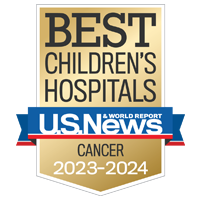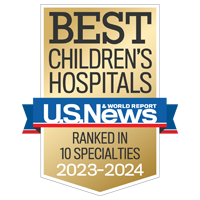Stress-free visits
Accommodations. Admissions. Procedure prep. Get the info you need for smoother hospital stays.
Prepare for your child's stay

Lymphoma is the third most common childhood cancer. It is cancer of the lymphatic system, which is made up of thin tubes that branch like blood vessels into all parts of the body. These lymph vessels carry lymph, a colorless, watery fluid containing white blood cells called lymphocytes. Along the network of vessels are lymph nodes, groups of small bean-shaped organs that make and store infection-fighting cells.
There are clusters of lymph nodes in the underarm, groin, neck and abdomen. The lymph system also includes the spleen, the thymus, and the tonsils. Because the lymph system is so extensive, lymphoma can start in many locations and spread to almost any organ or tissue.
There are two types of lymphoma – Hodgkin's and non-Hodgkin's. The cause for both diseases is unknown and occurs in one child in 10,000.
Non-Hodgkin's lymphoma occurs between the ages of 7 and 11. It affects boys almost three times more often than girls, and is more common among Caucasian children than among African-Americans and children of other races.
To request an appointment, give us a call.
There are three major types of childhood non-Hodgkin's lymphomas:
In many children, non-Hodgkin's lymphoma is already extensive when first diagnosed. About a third of cases originate in the neck or chest, a third in the abdomen and another third elsewhere in the body.
There is often pain and swelling at the site of the cancer. Other symptoms include:
If the cancer is in the abdomen, the area can become very swollen, sometimes so much as to look like a pregnancy. When the cancer causes the lymph tissue near the kidney or intestines to swell, passage of urine or feces through that area can become blocked, causing abdominal pain.
If the chest is involved, the head and neck may swell and cause breathing difficulty. The large vein that carries blood from the head and arm back to the heart, called the superior vena cava or SVC, passes next to the thymus. Pressure on the SVC from the cancer can cause the head, arm and upper chest to turn a bluish-red color. This is known as SVC syndrome and can affect the brain and threaten your child's life. Children with SVC syndrome need immediate treatment.
Many symptoms of non-Hodgkin's lymphoma could be caused by other conditions such as infections.
Your child's doctor may request a number of diagnostic tests, including:
This diagnostic imaging procedure provides detailed images of the body, including the bones, muscles, fat and organs.
A PET scan is a nuclear medicine test in which a radioactive compound is injected and shows the areas of malignancy in the body.
Biopsy is the removal of a sample of tissue to see whether cancer cells are present, and it is necessary to confirm the diagnosis. There are several kinds of biopsies. Your child's doctor will choose the one best suited for your child. The goal is to get enough tissue to make an accurate diagnosis as quickly as possible with the fewest side effects.
The following stages are generally used for childhood lymphomas:
The primary treatment for non-Hodgkin's disease is chemotherapy, which uses drugs to kill cancer cells and shrink tumors. Radiation therapy, or the use of high-dose X-rays or other high-energy rays to kill cancer cells and shrink tumors, sometimes is used. Bone marrow transplantation is being tested in studies of patients with advanced disease. The prospect for curing children is now about 70 percent overall.
Chemotherapy uses drugs to kill cancer cells and shrink tumors. It may be taken orally or may be administered into a vein or muscle by needle. Chemotherapy is called a systemic treatment because the drugs enter the bloodstream and can kill cancer cells throughout the body. Chemotherapy also may be injected by needle into the fluid that surrounds the brain or back to treat certain types of lymphoma that spread to the brain.
Radiation therapy, which uses X-rays at high doses in a very focused beam to kill malignant cells, is very effective in treating lymphomas. The side effects of this treatment vary depending upon which area of the body is being radiated.
Bone marrow transplant (BMT) is a newer treatment for lymphoma. Sometimes lymphoma cells become resistant to treatment with radiation therapy or chemotherapy. Very high doses of chemotherapy may then be used to treat the cancer. Because the high doses of chemotherapy can destroy bone marrow, marrow is taken from the bones before treatment. The marrow is then frozen and high-dose chemotherapy with or without radiation therapy is given to treat the cancer. The marrow that was removed is then thawed and returned by needle into a vein to replace the marrow destroyed by chemotherapy. This type of transplant is called an autologous transplant. If the marrow is from another person, the transplant is called an allogeneic transplant.
UCSF Benioff Children's Hospitals medical specialists have reviewed this information. It is for educational purposes only and is not intended to replace the advice of your child's doctor or other health care provider. We encourage you to discuss any questions or concerns you may have with your child's provider.
 3
3

Best in Northern California for cancer care

Ranked among the nation's best in 10 specialties
Stress-free visits
